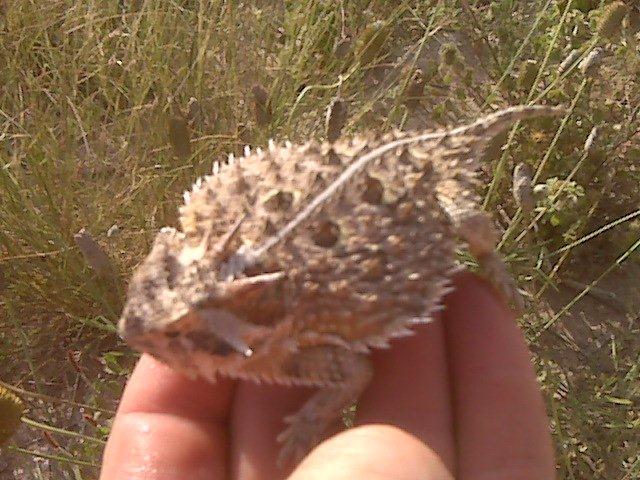Horned Lizard Conservation Society, www.hornedlizards.org
Mission Statement:
The Horned Lizard Conservation Society is a 501 C 3 non-profit organization dedicated to protecting horned lizards throughout North America. Our mission is to document and publicize the values and conservation needs of horned lizards, to promote horned lizard conservation projects and to assist with horned lizard management initiatives throughout their ranges.
 Horned Lizard Conservation Society
Horned Lizard Conservation Society
PO Box 122
Austin, TX78767
phrynosoma@hornedlizards.org
Learning from Lizards; horned, that is
Joyce Gibson Roach
 A number of books, mostly for young readers, with titles that include What Dogs Have to Teach Us, also cats, horses, longhorns, and other animals, have appeared in the last few years. They are lavishly illustrated with photos and/or art work. Each has good advice and counsel drawn from the habits noticed by humans who anthropomorphize animal behaviors for the benefit of homo sapiens. Yes, I have been guilty of giving human voice to animals horned, fanged, hoofed, and winged in a book for children, but never noted any qualities worth emulating.
A number of books, mostly for young readers, with titles that include What Dogs Have to Teach Us, also cats, horses, longhorns, and other animals, have appeared in the last few years. They are lavishly illustrated with photos and/or art work. Each has good advice and counsel drawn from the habits noticed by humans who anthropomorphize animal behaviors for the benefit of homo sapiens. Yes, I have been guilty of giving human voice to animals horned, fanged, hoofed, and winged in a book for children, but never noted any qualities worth emulating.
It was my intention to note the worthy attributes of horned lizards in this essay, but when numbering the traits that offer life lessons, the list was slim to none. They bluff to protect themselves—puff up, raise up on their front legs, squirt blood, dart and run hunting for camouflage—hibernate through winter; lay eggs but don’t stay around to see them hatch; live off ants mostly; and are part of the food chain for a few animals and birds. Horned lizards behave according to the dictates of weather and land because they are reptiles and therefore cold-blooded.
Moving out of the romantic climate surrounding the animals noted above, it must be admitted horned frogs don’t have much of anything to teach anybody. The title, Learning from Lizards is personal and has only to do with what horny toads have taught me in the last ten or twelve years since joining HLCS.
You don’t have to call them by their scientific name, Phrynosoma Cornutum, or by their identification in Español—sopa con quernitos, or chameleon—or even horned lizard. Other identifications already used are just fine.
Those who enjoy, study, survey, popularize, advertise, advocate, remember them, and just plain like them aren’t all alike either. Some are biologists, naturalists, artists, photographers, folklorists, historians, veterinarians, lawyers, writers, students, old, and young.
I can only speak for myself, then, about what I’ve learned from lizards and it has little to do with the tiny, elusive creatures, themselves.
In the companionship of Society members out in the vastness of West Texas mostly, I have learned to look at the ground with care and curiosity about grasses, wildflowers, things that crawl and/or fly. Some names I’ve learned; some not except to notice colors shaded and blended on single petals, repetition of shapes; patterns of variety on insects, their work ethic as the seasons roll. Scientific identification is mostly bugs and blossoms, colors never noticed until observed at ground level, sunshine on tiny wings, or spotlighting grass moving in the wind. Before, my view of the ground was a wider perspective that stretched as far as the land was unbroken—the entire sweeping panorama of the beloved prairie and plains.
I couldn’t see the trees for the forest—yes, I said it right, for me at least. The various veining and colors of leaves as seasons change; the fruits and nuts that appear, or don’t according to wind, weather, and water; the size and shape of trees—even the smell of oak and prickly ash in the inferno of summer. Few names except for the most obvious are important to me now at this stage of my life even though there is plenty of time to learn.
And birds that occupy the trees and grasses! Raptors are my favorites now. Perhaps it’s because I can see them more easily than the smaller ones, and know their general names—hawks, owls, eagles now and then—and their calls. It’s their eyes that please me most—fierce, unafraid, confident. I have learned a few of the names of smaller birds by their call, although never see them—the Phoebe for one.
In spite of this late-life epiphany as clear as ever the three wise men experienced, I have no want to become a birder, a master naturalist, wildlife expert, or sage. Having always had the big picture, so to speak, the wider, all encompassing view of the natural world, I am satisfied with the endless bits and pieces of Place close up, knowing I belong there and it in me. To paraphrase Walt Whitman, I have seen the world in a blade of blue stem, am a person of small perspectives at home in the world.
Without hunting for Phrynosoma, horned lizards, horny toads, and horned frogs in the company of others of like mind, I would have missed one of the most important lessons of life, on earth as it is.
